Menu
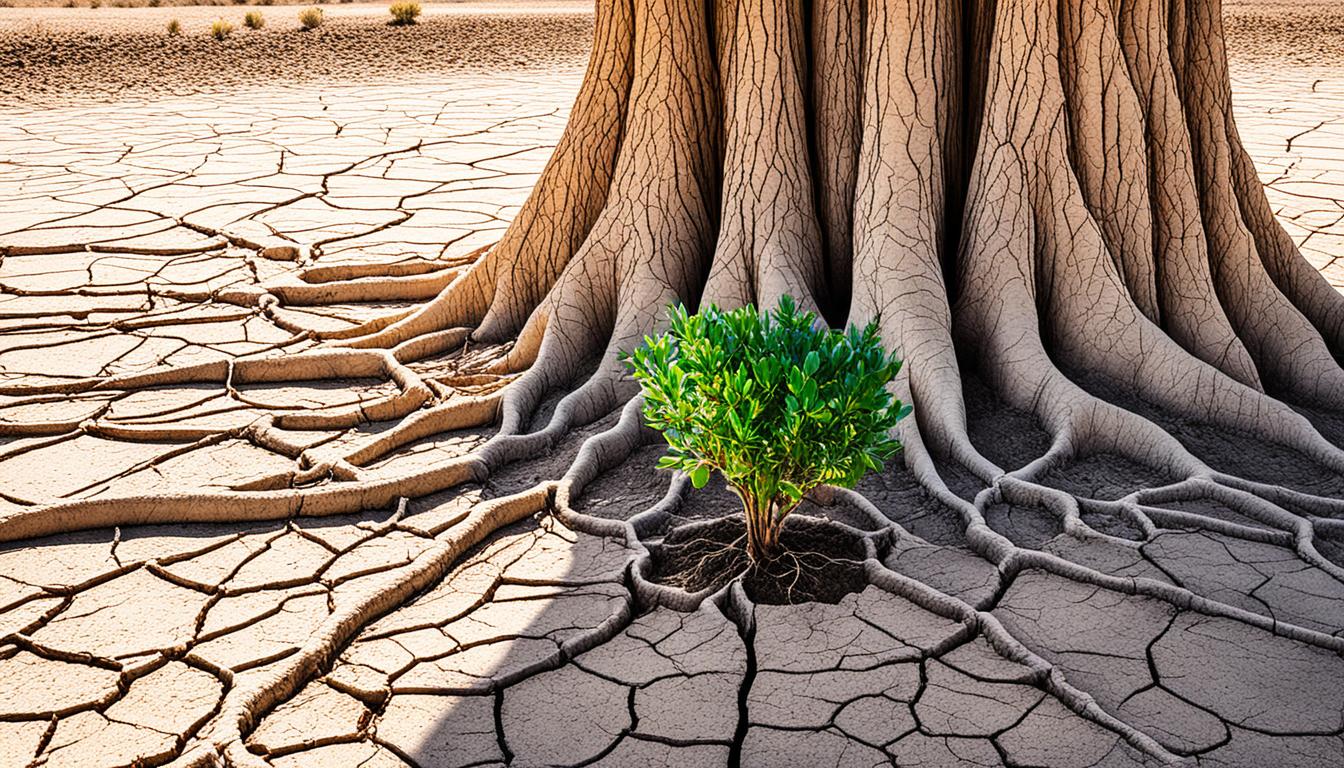
During dry periods, farmers often have to sell more cattle. This leads to too many cattle for sale and lower prices. This shows why it’s crucial to use good drought management methods. These help protect our water sources and lessen the harm to farming.
To fight drought, we have to be ready before it hits. We need to use actions that match the current weather. This keeps our water safe and our farms running better. We must be smart and flexible in how we take care of the land. This guide will help with that.
Drought management is a key part of keeping agriculture sustainable. It’s about knowing how drought affects everything and using smart ways to lower these impacts. By tackling both the impact of drought and proactive drought management, we can do better when facing these environmental challenges.
Drought doesn’t just mean less water. It messes with nature, hurts the soil, and changes the plants and animals around us. Farming takes a big hit, with crops and livestock suffering. The knock-on effect hits jobs and local food supplies. It’s important for farmers to watch how many animals they have, so they don’t harm the land. Using techniques like moving animals around has been a big help.
Being ready for droughts means getting a plan together well before things get bad. There are good ways to keep animals that help the land, like moving cows from place to place. Farmers and ranchers who adjust their stock levels just right can do better in hard times. This means they can earn more money, even during droughts. It’s also smart to plan ahead and keep a close eye on the grass and water quality.
Proactive drought management steps are key to facing environmental challenges. They help agriculture bounce back and protect our natural world and economies when water’s short. These actions are really important. They help lessen bad effects and make sure we can all have a good future.
Preparing for drought means checking your water sources. It’s important to know what water you have now. Then, use the best ways to save water, so there’s enough even in droughts. This part looks at keeping track of water and ways to use less of it when needed.
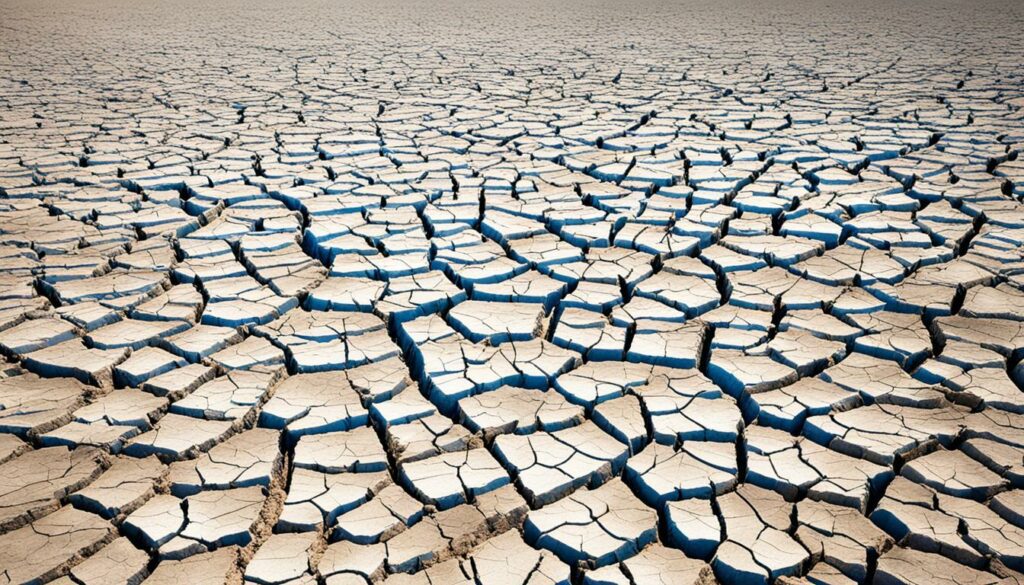
Checking water often is key to using it well. A big problem is losing water before it gets used, especially in dry and fire seasons. New ways, like using twins in digital form, help people guess when water will be needed most. This reduces waste and makes sure water is used wisely.
To fight drought, we must save water ahead of time. Many places are learning to manage water better, from the government to our homes. They build dams, save rainwater, and join projects to use water wisely. Groups and others also teach us how to use less water in daily life. Doing these things protects our drinking water and uses less energy.
As the world gets warmer, saving water becomes more important. Using new tech and planning in advance can help a lot. This way, we can leave enough water for those who come after us.
“Water management is not just a necessity, but a responsibility shared across all segments of society. By adopting innovative technologies and sustainable practices, we can make a profound impact on conserving our precious water resources.”
Good grazing management is key, especially in dry spells. By controlling how many animals are in a field, using rotational grazing, and planting tough grass, farmers can make the most of their land. This helps keep the animals well-fed when water is scarce.
Getting the right number of animals in a field is crucial. The amount should change yearly, depending on how much rain there is. In a drought, having fewer cattle, like about 75% less, can make the farm more money. Farmers in dry areas find that having fewer animals keeps their fields healthy and productive.
Rotating animals between fields is good for both the land and the livestock. It helps the grass grow back stronger, which means more food for the animals. This method is even more helpful in a drought because it gives the grass a chance to rest and grow better. It’s a vital part of a plan to keep the farm going strong in hard times.
Having tough, drought-resistant plants can be a lifesaver. They let farmers have food for their animals even when there’s little rain. These plants don’t mind the dry weather. Adding them to the farm can help keep things stable and support the farm’s future.
| Strategy | Benefit |
|---|---|
| Proper Stocking Rates | Improves profitability and pasture health during drought |
| Rotational Grazing | Enhances harvest efficiency and forage utilisation |
| Drought-Tolerant Pastures | Provides a resilient food source for livestock |
Keeping soil moist is key for farming, especially where water is scarce. Methods to hold water in soil help it stay fertile. They also boost productivity and make land more resilient in dry times.

Mulching means covering soil with natural or man-made stuff. It lowers water loss, stops weeds, and keeps soil warm. It’s like a blanket that protects soil from the sun and wind.
Adding mulch can make soil keep more water. This means farms need less extra water to grow crops.
Leaving plant leftovers on soil helps keep moisture in. This is stuff from old crops and weeds. It works in a few ways:
Using these methods can save money as they’re not too costly. Setting them up is fast, so farmers like them.
| Method | Benefits | Challenges |
|---|---|---|
| Mulching | – Uses less water – Stops weeds – Keeps soil right for plants – Feeds soil | – Finding enough mulch – Hard work to put it down |
| Plant Residue | – Keeps soil from drying out – Makes soil better – Stops soil from moving – Feeds soil | – Need enough old crops – Hard to plant again |
Drought happens often during the growing season. This makes drought-resistant crop cultivation important. It helps crops survive and use water well. Farmers choose the right crops and use smart crop rotation. This boosts their fields’ ability to withstand drought and keeps them productive.
Picking the right crop types is key in drought-resistant crop cultivation. These crops can survive dry conditions. According to the USDA Soil Conservation Service (NRCS), taller grasses in pastures can help. They make places cooler, lose less water, and resist drought better. Crops like sorghum and millet have deep roots. This helps them find water and nutrients well. They are great for dry areas.
Crop rotation is crucial for dealing with drought. It keeps the soil healthy, lowers illness chance, and keeps water better. For example, planting corn after plants with deep roots leads to deeper-rooted corn. This corn is better at handling drought and gives more crops. Including cover crops in the rotation raises the soil’s organic matter. This helps the soil hold more water. In fact, every 1% rise in soil organic matter can store up to 20,000 gallons of water per acre. This makes fields better at surviving drought.
Using sustainable agriculture techniques like crop rotation helps fight drought’s dangers. It also supports long-lasting farm success and saves the environment. By applying these methods well, farmers can grow crops that do well in tough situations. This makes sure there’s enough food and keeps the economy strong.
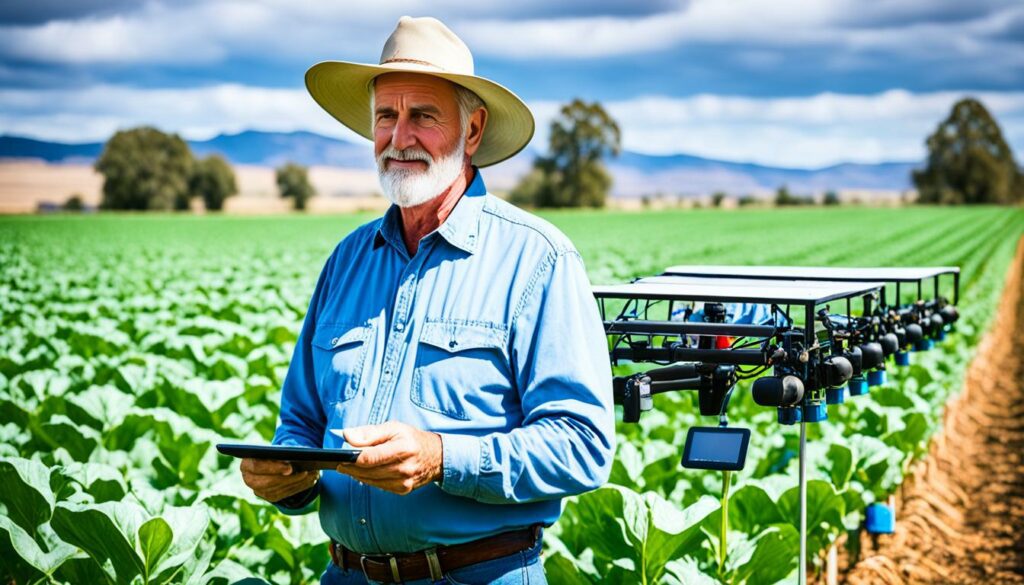
Enhancing irrigation efficiency helps fight drought effectively. Choosing the right irrigation systems and water usage times boosts farm sustainability. This supports our ability to grow food with less water.
Using different irrigation systems saves a lot of water in farming. Drip and sprinkler systems are great for not wasting water. They water plants directly, helping to keep water from evaporating or running off. Instead, it goes right to the roots. Deep soils can also store water, which means less water is wasted. This is especially good for crops like alfalfa, which can wait out dry periods.
When to water is key for crop health, especially during droughts. Less water stress means crops suffer smaller losses. But, water at the wrong time – like during flowering – causes big problems.
However, if crops lack water early on, they might not yield as well, but usually do not outright die.
Cutting water too much, more than half, really hurts crop yields. Fewer crops watered better can do as well or better than many crops with less water. Choosing the right time to water is crucial for using water well.
Storing water on farms is a smart move during dry spells, but it can be costly to start. In Europe, farming takes up a big share of the water used. The Southern parts are facing even less water in the soil over time, needing more irrigation. This puts pressure on using water smartly in those areas.
With energy and water getting more expensive, the cost of running an irrigation system also grows. But, investing in a good system can save money in the long run and help the environment. The EU helps farmers take these steps with financial support. This way, farming can keep going strong while saving water.
Understanding feed testing and water quality is key in managing animal health, especially in a drought. This is vital to keep livestock healthy when there is a lack of resources.
During a drought, the quality of feed can suffer, affecting animals’ nutritional intake. Parameters like protein, fibre, and digestibility often change. Regular testing is needed to meet animals’ nutritional needs.
Testing feeds for nitrates, especially in crops like cereals, is crucial for safety. It helps decide when to start using other feeds, keeping animals healthy and productive.
Managing water quality is crucial alongside feed checking, especially in drought. Bad water sources can stress animals and cause diseases. Regular testing and filters can lower these risks.
It’s essential to ensure water safety to avoid health problems in animals. Including water quality in drought plans keeps animals healthy and productive, even in tough times.
This joined-up approach to feeding and water is vital in managing drought well. Studies show that enough litter in forage can boost production. This proves the importance of caring for both feeds and water.
| Parameter | Impact During Drought | Management Strategy |
|---|---|---|
| Crude Protein | Declines | Regular feed testing |
| Fibre | Increases | Supplementary feeds |
| Nitrate Accumulation | Risky levels in cereals | Nitrate testing |
| Water Quality | Contamination risks | Quality management |
Using sustainable farming methods is a key way to improve resistance to drought. By mixing livestock with crops and using conservative tillage, farmers can build strong, effective systems.
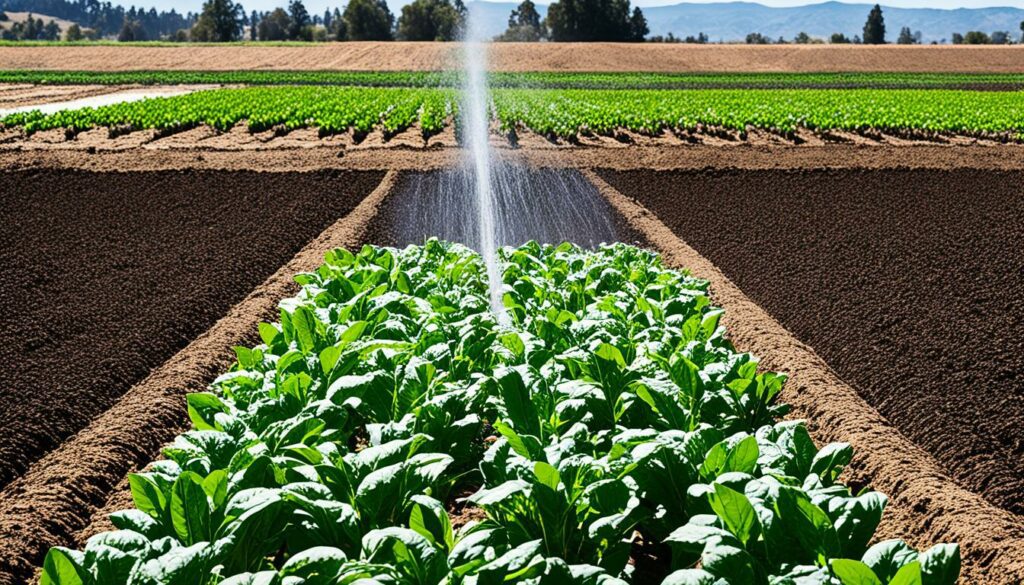
Integrating livestock and crops in farming brings many benefits. It helps with nutrient recycling, making the soil richer and better at holding water. This means less need for chemical fertilisers, saving money and making the environment healthier.
Also, animals eating grass can cut down weed growth, which helps the crops. This balanced way of farming creates a varied environment that can cope better with drought.
Conservation tillage means not disturbing the soil much to keep its structure and moisture. It’s a key approach in managing drought risks, especially where droughts are common. Studies show it cuts down on water loss. For example, in Kentucky, using this method reduced water loss by a lot.
It’s also found that increasing the organic matter in soil by just 1% can store loads more water. This is a big deal in areas often hit by drought, making conservation tillage very important.
Adopting conservation tillage and integrating livestock with crop production leads to a balanced ecosystem that is capable of withstanding diverse environmental stresses, including severe drought conditions.
When drought hits, keeping livestock well-fed becomes hard. Places like Georgia face this challenge a lot. They have to find new feeds and ways to feed their animals right to stay healthy and productive.
When regular food is hard to find, finding alternative feeds is key. Pelleted feeds, like alfalfa pellets, are a smart choice. They cost between $200 and $300 per ton, cheaper than hay at $350 to $400. Using crop leftovers for animals to eat after the harvest saves money too.
But, adding minerals, proteins, and energy to their diet is a must. Drought can make plants collect harmful nitrates fast. So, it’s important to watch out for those.
Adding extra feed to the animals’ diets is crucial during drought. For example, feeding early-weaned calves well really works. They should eat 4 to 5 pounds of feed to gain a pound, with a lot of that being corn and soybean meal.
Lactating cows need feed with at least 15 percent protein, but 12 percent is fine if they’re not producing milk. For them, feeding grains less freely and adding range cubes or liquid supplements in small amounts helps. This keeps their diet balanced.
The need for different feeds is going up because normal feed is getting more expensive. This, along with less water for crops and lower hay production, makes good feeding harder. Checking the feed’s quality before giving it to the animals is very important. It keeps them from getting sick and makes sure they get what they really need.
Good land use planning helps fight the bad effects of drought. It makes sure we use our resources wisely and keep farming going. To manage drought risks well, we need to really look at our land and make a thorough plan. This plan helps us now and in the future, tackling any unknowns ahead.
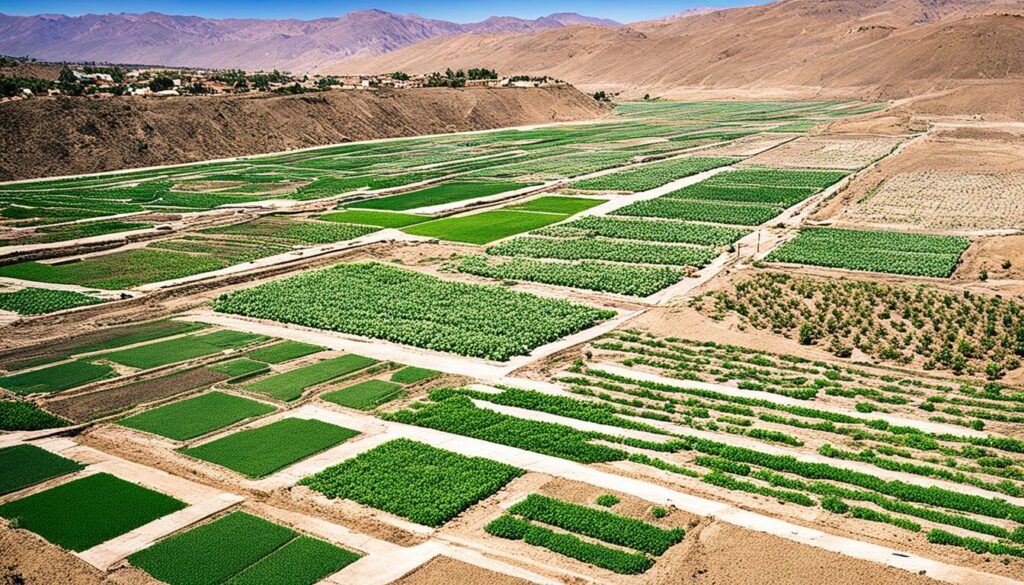
It’s key to check the kind, place, and size of our land, and its dry history. The Federal Emergency Management Agency (FEMA) works with others to use this info in plans to lower risks. These plans need to spell out how bad nature threats, like drought, can hit people.
Looking at different places, some with good planning cut big money losses from drought by 40%. This shows how vital it is to blend methods for fighting drought into our plans. Most planners, 78%, already do this.
Planning ahead for a drought means taking some smart steps. FEMA and other groups help with advice, tools, and support for making these plans. The plans get us ready for less water and cut down on damage. Adding nature-friendly designs in cities, rules for how we landscape, and how we manage rainwater fights drought best. Nearly everyone, 92%, sees this as key.
Also, adding drought planning to other city plans can help tackle drought’s big challenges. The National Integrated Drought Information System and others help with facts and tools for this. Good drought planning checks on drought signs early, figures out what can get hurt, and teams up on ways to lower the hit. This includes smart ways to look after the land that have nature and disaster risk in mind.
Using the right drought management techniques is key in changing climate. An important strategy is keeping cattle at about 75% of what the land can support. This helps farms make more money even in dry years. It eases the stress on the land and water, making the farm more sustainable when times are tough.
In south Texas, a smart way to handle things is to keep fewer cows. They only keep 40% of what the land can handle and use stocker calves as ‘flex grazers’. This reduces stress on the land and keeps the farm profitable. These methods show how thinking ahead and being flexible are vital in hard times.
If you stock too many cows in wet years, you might have to sell some when drought hits. This leads to too many cattle on sale and prices going down. It shows the need to plan well, knowing how much your land can support. By adjusting the number of cows you have, you can avoid these market problems.
For short drought spells of 4 to 6 weeks, adding 50 to 75 lbs of nitrogen per acre can help the land. But if drought lasts over two months, it’s better not to use fertiliser. This saves money and keeps your resources ready for better times.
Some practices, like using herbicides and setting fires, don’t work during drought. They show bad farm management. Instead, hay from fields that can’t grow properly can go to feed. Also, it’s good to cut hay fields only once a year, before July 10. This keeps the fields and pastures healthy.
| Drought Management Techniques | Details |
|---|---|
| Maintaining Reduced Cattle Numbers | Approximately 75% of long-term carrying capacity, higher net profitability. |
| Adoption of Flex Grazers | Stocker calves as flex grazers, 40% of total carrying capacity, positive cash flow. |
| Adjusting Fertiliser Application | 50-75 lbs nitrogen per acre during short droughts; withhold during prolonged droughts. |
| Avoid Herbicide Use | Herbicides ineffective under dry conditions. |
| Reduce Hay Cutting | Cut hay meadows only once per year, before July 10. |
To deal with drought, mix different drought management techniques. This means using adaptive farming strategies and taking good care of the land. Doing this protects farms during dry times and supports long-lasting success.
The world’s weather is changing fast. This means farmers need new and smart plans to keep their farms strong. By watching how the weather moves and changing their methods early, they can do better despite the climate’s surprises.
Farming must change with the changing weather. This means farmers must pay close attention to when it’s getting hotter, wetter, or colder. They need to make plans to use less water during dry times, which can cost between 50,000 and 100,000 euros. The actual cost depends on where the farm is and how bad the drought is. The European Commission says using water wisely and saving water is crucial. They have advised looking at our progress and what more needs to be done to stop water shortages.
It’s not just about the weather; it’s about how farms can stand strong against it. This involves following rules like using water again in farming. Getting everyone involved, from scientists to the people who make the rules, is key. Together, they make plans to keep rivers and water bodies healthy and to know early when droughts might hit. This teamwork helps farms keep growing and stay eco-friendly even in hard times.
During drought, it’s vital to watch over plant health. This helps keep our farming strong. We need to spot stress signs early and make sure plants have the right nutrients.
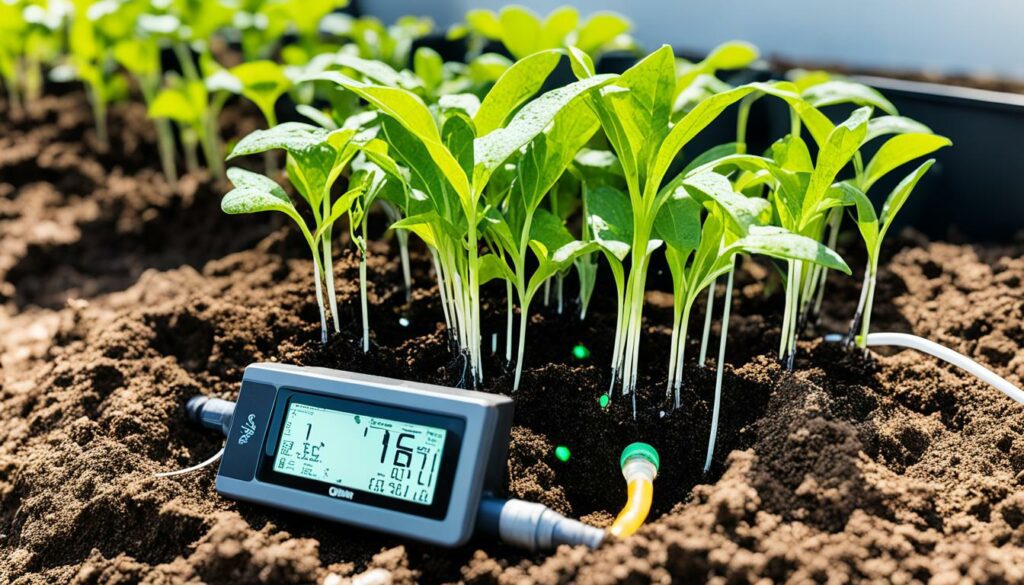
Seeing stress signs like wilting and yellow leaves is crucial. These signs tell us that plants need help fast. It’s known that very hot soil slows down how plants get nutrients, making drought stress worse.
Taller grass means better drought resistance. This is key in fighting plant stress.
It’s key to keep nutrients at the right level for plants to fight drought. Lack of water makes it hard for plants to take up nutrients. Adding organic matter can make soil hold more water, helping plants stay healthy.
Microirrigation is great for making sure plants get enough water and nutrients. It’s very efficient, especially when there’s not much rain.
| Nutrient Management Tactic | Benefit |
|---|---|
| Regular Soil Testing | Identifies deficiencies promptly |
| Organic Matter Integration | Enhanced water retention and nutrient availability |
| Microirrigation | Efficient nutrient uptake |
By keeping a close eye on plants, finding stress signs early, and managing nutrients well, we can beat drought’s effects. This smart work helps our farms stay strong when water is scarce.
Managing drought well means looking at both practical steps and smart money choices. Knowing the financial side of drought helps avoid big losses and makes businesses more profitable. It’s not just about what you do, but also about making good choices for your wallet.
Figuring out what drought actions make sense money-wise is key. This means looking at the costs and benefits of different strategies. Doing this helps choose the best options for making farms more drought-resilient.
Rotational stocking, for example, can make feeding your animals more efficient when it’s dry. But, it can be costly buying extra feed. You might also think about reducing your animal numbers or using stocker calves differently. These moves can cut costs and boost your bottom line.
This careful look at strategies helps farmers plan better and stay in the black during droughts.
Getting help with money is crucial when drought hits. Grants, loans, and support can keep farms going through dry times. For example, the USDA has programmes to help with drought risks and the environment. Financial aids can support sustainable farming, especially in places with often-recurring droughts.
Proactive financial planning also helps during drought. Seeking help early, like funding for water access, can lessen the economic blow of severe droughts.
Taking an active role in community drought efforts is key to lessen dry spells’ impact. By partaking in community farming and water projects, we help everyone. These actions lead to sharing insights, resources, and a strong support network during tough times.
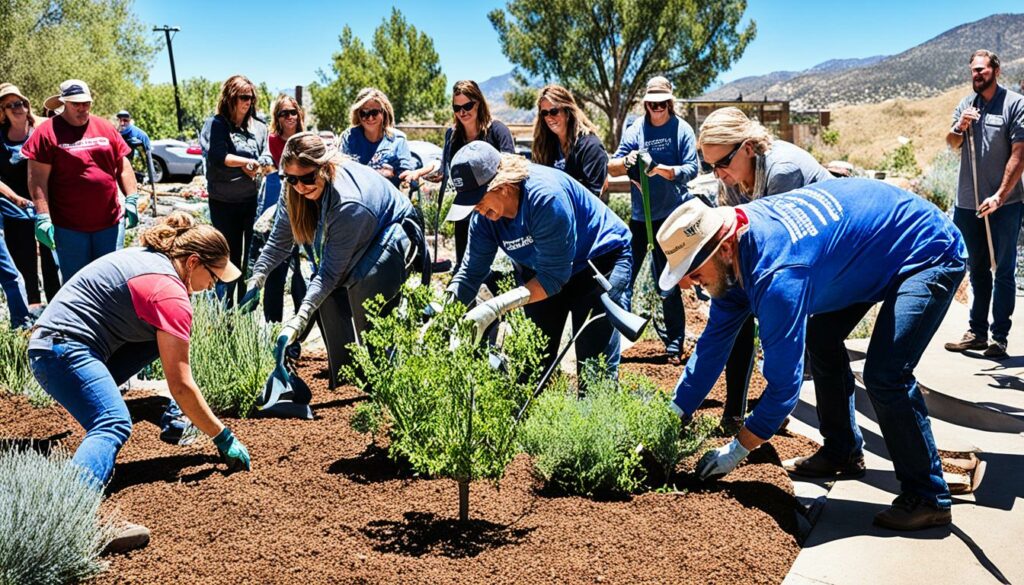
Joining in local water programmes is important for managing droughts. In our area, 78% of people have taken part in water saving drives, showing team effort’s strength. These schemes offer training that boosts water-saving habits. A joint project increased local farmers’ water saving by 40%, proving these efforts work.
Working together is vital for handling drought on farms. Cooperating farmers exchange tips, promoting new ways to cope. By working together, they cut water use by a quarter through sharing watering schedules. Also, nearly every home uses drought-friendly planting after community advice, showing how shared ideas help.
The same data highlights the need for smart grazing in dry times. Farmers in dry areas use clever methods to keep their livestock in good shape without spending much. They often keep only 75% of usual animal numbers or use extra young animals for grazing. This way, they reduce costs on feed without losing out on their animals’ well-being.
In the past 40 years, droughts have been the top disaster affecting many people. This shows we urgently need better ways to handle droughts. With only 0.003% of water on Earth being fresh, we must turn to new technologies for farming.
Precision agriculture is a huge help in using water wisely. Drip irrigation, for example, gives just enough water to plants, which stops waste and reaches roots directly. A special study found plants can be up to 25% more water-efficient in dry spells. Solar pumps are also becoming more common for farm watering. They lessen the need for fossil fuels, hence using less electricity.
Remote sensing and drones are now key in farming. They let us keep an exact eye on fields and act quickly when needed. The USDA has made two new tech tools for managing drought. Meanwhile, Acclima, Inc. made sensors to check soil water. They have both small, hand-held sensors and bigger ones for deeper soil checks.
Planting trees has been advocated to mitigate drought effects, improve the environment, and enhance precipitation success.
| Statistic | Details |
|---|---|
| Drought Impact | Affects more people than any other natural disaster in the last 40 years. |
| Fresh Water Scarcity | Only 0.003% of the Earth’s surface water is fresh water. |
| Rainwater Absorption | 15% in urban areas, 50% in rural areas. |
| Crop Water Efficiency | Improved by up to 25% with new research methods in drought conditions. |
After looking at many ways to handle droughts, we see that using many methods is best for farming’s future. Proactive and flexible approaches are key to lessening drought harm. For example, keeping the right number of animals and rotating where they graze help make the most of what’s growing.
Using Best Management Practices (BMPs) can make farms stronger against climate change. In Canada, a new plan led by the government aims to face drought countrywide. This plan, part of the bigger AAFC Strategic Water Plan, highlights the need for research, readiness, and a fast response to protect farming.
When it comes to making hay, the focus should be on good quality and enough dry grass, especially when it’s dry. Using herbicides or fires in dry times doesn’t work well and costs a lot. The main point is, waiting to make hard choices like cutting down on animals can lead to more money problems. To keep agriculture going, we must use smart methods and keep improving how we deal with droughts. This is crucial for keeping farms productive and profitable in a world that’s facing more droughts.
To manage drought well, prepare ahead, protect water sources, use rotational grazing, keep soil moist, and check feed and water quality often.
Track water, save as much as you can, and make a plan to use what’s left wisely. It’s all about knowing how much water you have and need.
Keeping soil moist keeps it fertile. Use mulch and keep bits of plants on the ground. This stops water from escaping and the soil from being blown away.
Grow crops that don’t need a lot of water. Change what you grow in your fields regularly. This helps use water better and stops your crops from dying out.
Pick the best ways to water your crops and time it right. This saves water and helps your plants grow strong and healthy.
Mix farming and animals and treat the soil right. This makes the land keep water better, helps plants grow, and supports wildlife. All these help deal with less water.
Test what you feed your animals to make sure it has everything they need. Keep their water clean to avoid sickness and stress. Use different foods and vitamins when grass is scarce.
Moving animals from place to place uses the fields better. This keeps the animals healthy even when there’s little water.
Look at your land, see what could go wrong, and make a plan to fix it. Doing this keeps your farm running even in dry times.
Change is happening, and we must be ready to keep farming well and protect what we have. Understanding and adjusting to new weather helps our farm stay strong.
Use new gadgets like smart farming, seeing far with satellites, and flying drones. They help watch over your farm, save water, and grow better food.
Joining with others and working together makes everyone stronger against drought. Sharing ideas and resources helps a lot when times are tough.
Figure out the costs and wins of ways to fight drought. Look for help with money like grants and loans. Knowing these things helps you choose the best path during hard times.